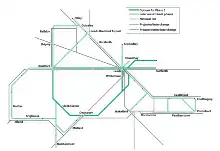| West Yorkshire mass transit system | |
|---|---|
 West Yorkshire Mass Transit diagram | |
| Overview | |
| Owner | West Yorkshire Combined Authority |
| Area served | West Yorkshire |
| Locale | Bradford, Halifax, Huddersfield, Leeds, Wakefield |
| Transit type | Rapid transit Tram Bus Commuter rail BRT[note 1] |
| Number of stations | To be determined |
| Operation | |
| Operation will start | c. 2028 |
WYMT Bradford lines | |||||||||||||||||||||||||||||||||||||||||||||||||||||||||||||||||||||||||||||||||||||||||||||||||||||||||||||||||||||||||||||||||||||
|---|---|---|---|---|---|---|---|---|---|---|---|---|---|---|---|---|---|---|---|---|---|---|---|---|---|---|---|---|---|---|---|---|---|---|---|---|---|---|---|---|---|---|---|---|---|---|---|---|---|---|---|---|---|---|---|---|---|---|---|---|---|---|---|---|---|---|---|---|---|---|---|---|---|---|---|---|---|---|---|---|---|---|---|---|---|---|---|---|---|---|---|---|---|---|---|---|---|---|---|---|---|---|---|---|---|---|---|---|---|---|---|---|---|---|---|---|---|---|---|---|---|---|---|---|---|---|---|---|---|---|---|---|---|
| |||||||||||||||||||||||||||||||||||||||||||||||||||||||||||||||||||||||||||||||||||||||||||||||||||||||||||||||||||||||||||||||||||||
The West Yorkshire mass transit system, is a proposed transport system connecting the larger conurbations of West Yorkshire, England, with a central hub at Leeds. The city of Leeds is known to be the largest city in Western Europe without a light rail or metro-style system.
Background
Mass transit systems have been considered in the region before, mostly focussing on Leeds, which had a Supertram project gaining royal assent in 1993 - conventional tramways existed in Leeds up until 1959.[1] The route was to have proceeded north from a point near to the old M621/M1 motorway junction[note 2] into central Leeds as route 1, with extensions north to Headingley, and east to the St James area.[2] By 2001, costings had increased to £487 million for the project,[3] and by the time the project was cancelled by Alistair Darling in 2004, over £39 million had been spent developing the system.[4][5]
A £250 million trolleybus system was also proposed, which was cancelled in 2016.[6]
Development
When the Integrated Rail Plan was released in November 2021, it was revealed that the eastern leg of the HS2 project into Leeds was cancelled. Instead, a mass transit system, as proposed by the West Yorkshire Combined Authority, was given funding to progress. Some have labelled this as a "consolation prize", whilst it has been noted that Leeds is the largest city in western Europe without a metro-style system.[7][8] The mass transit system aims to connect 675,000 people across the West Yorkshire region.[1] Additionally, the HS3 line across the Pennines was cancelled on its Yorkshire section. Proponents had hoped that this would see a through line and station built in Bradford. In March 2022, the transport minister, Andrew Stephenson, stated that the passenger numbers of those travelling between Bradford and Manchester was low compared to those travelling from Bradford to other places within West Yorkshire, which was why the government favoured a mass transit system and route upgrades, rather than building a new line.[9]
In March 2022, £200 million was approved to bring the project forward, with an estimated value of £2 billion.[10] However, the £200 million funding may be halved as £100 million may be allocated to investigate whether HS2 trains could travel to Leeds on conventional railway tracks.[11] In September 2022, a new study, called "The Leeds Study", was launched to look at the integrated rail plan of West Yorkshire, with a focus on capacity at Leeds railway station, and the development of the mass transit system.[12]
If approved, construction is expected to start in 2028, with the first services starting in 2031, and the whole system completed by 2040.[1] A report in September 2022 stated that two routes radiating from Bradford would be the first to be developed; Bradford to Dewsbury, and Bradford to Leeds.[13]
Notes
- ↑ A decision has yet to be taken on whether the system will be just one type, or a combination of the types listed here.
- ↑ The A1-M1 link road opened in 1999, and the original formation of the M1 was re-designated wholly as the M621.
References
- 1 2 3 Hyde, Nathan (21 July 2022). "Updated services for mass transit may run in 2031". The Yorkshire Post. p. 9. ISSN 0140-0460.
- ↑ Wainwright, Martyn (21 July 2000). "Labour's transport plan: The future: Pioneer puts trust in integrated strategy for city: Hopes high for 'jewel in crown'". Newsbank. Retrieved 11 March 2022.
- ↑ Newman, Cathy (29 March 2001). "Prescott accused of U-turn on road schemes". Financial Times. p. 2. ISSN 0307-1766.
- ↑ Bijl, Rob van der (2018). Light Rail Transit Systems : 61 Lessons in Sustainable Urban Development. Amsterdam, Netherlands: Elsevier. p. 11. ISBN 0128147849.
- ↑ Webster, Ben (24 August 2006). "£1 billion wasted on transport schemes that fail to arrive". The Times. No. 68787. p. 8. ISSN 0140-0460.
- ↑ "Leeds' £250m trolley bus scheme rejected". BBC News. 12 May 2016. Retrieved 11 March 2022.
- ↑ Pritchard, Robert, ed. (January 2022). "Levelling up, or not?". Today's Railways. No. 239. Sheffield: Platform 5. p. 7. ISSN 1475-9713.
- ↑ Pritchard, Robert, ed. (January 2022). "HS2 Eastern leg scrapped in Integrated Rail Plan". Today's Railways. No. 239. Sheffield: Platform 5. p. 9. ISSN 1475-9713.
- ↑ Sherratt, Philip, ed. (May 2022). "Bradford will benefit from IRP, says minister". Modern Railways. Vol. 79, no. 884. Stamford: Key Publishing. p. 10. ISSN 0026-8356.
- ↑ Hyde, Nathan (11 March 2022). "£200 million set to be spent on mass transit system". The Yorkshire Post. p. 9. ISSN 0140-0460.
- ↑ Burn, Chris; Hyde, Nathan (19 November 2021). "Brabin on attack over £100m review of Leeds link". The Yorkshire Post. p. 1. ISSN 0963-1496.
- ↑ Hyde, Nathan (8 September 2022). "Two-year wait for high-speed rail study". The Yorkshire Post. p. 5. ISSN 0963-1496.
- ↑ Young, Chris (17 September 2022). "Mass transit planners reveal links". The Yorkshire Post. p. 22. ISSN 0963-1496.